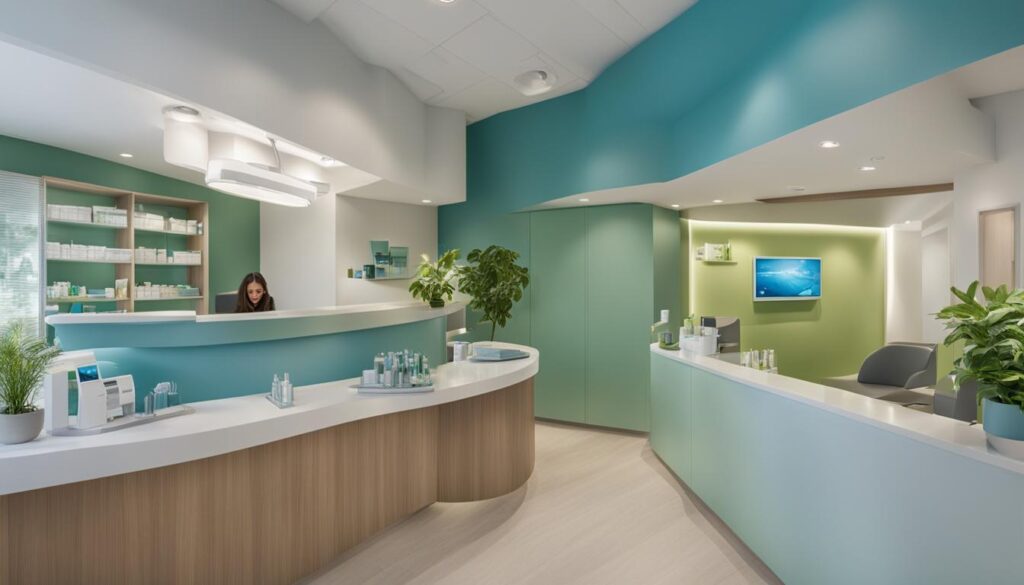We may earn money or products from the companies mentioned in this post.
Retaining patients is crucial for the growth and success of your dental practice. Patient retention not only ensures a stable revenue stream but also fosters strong dentist-patient relationships, leading to positive word-of-mouth referrals. Implementing effective dental patient retention strategies can enhance patient loyalty and satisfaction, ultimately contributing to practice growth.
In this article, we will explore various dental patient retention strategies, from prioritizing patient satisfaction to enhancing communication and personalizing patient experiences. We will also provide tips for creating an effective patient retention plan to improve patient loyalty and retention rates.
Key Takeaways:
- Implementing dental patient retention strategies is essential for practice growth and success.
- Prioritizing patient satisfaction and enhancing communication are key retention strategies.
- Personalizing patient experiences can strengthen patient loyalty.
- Creating a patient retention plan can improve retention rates and contribute to practice growth.
Prioritizing Patient Satisfaction
When it comes to retaining patients in your dental practice, patient satisfaction is paramount. Patients who feel valued and heard are more likely to return to your practice and refer others. Therefore, it’s essential to prioritize patient satisfaction in your practice.
Effective communication is one of the most important strategies for improving dental patient satisfaction. Taking the time to listen to your patients’ concerns and answering their questions in a clear and concise manner can significantly enhance their experience. Additionally, utilizing patient-centered communication strategies, such as motivational interviewing and shared decision-making, can further improve patient satisfaction and engagement.
“Patients who feel valued and heard are more likely to return to your practice and refer others.”
Another effective strategy for improving patient satisfaction is to offer patient-centered care. This approach involves tailoring treatment plans and care to meet individual patient needs and preferences. By prioritizing patient-centered care, you can improve patient satisfaction and increase their sense of control and involvement in their oral health.
Lastly, it’s important to ensure that patients feel comfortable and at ease throughout their visit to your practice. This includes maintaining a welcoming and friendly environment, providing amenities such as water or magazines in the waiting room, and ensuring that patients are informed and involved in their care throughout the visit.
Dental Patient Communication Strategies
In order to enhance patient satisfaction, it’s essential to utilize effective communication strategies. This can include:
- Active listening
- Using clear and concise language
- Offering patient-centered care
- Utilizing motivational interviewing and shared decision-making
- Providing education and resources to patients about their oral health
By prioritizing patient satisfaction and utilizing effective communication strategies, you can enhance the patient experience and improve patient retention in your dental practice.
Implementing Patient Referral Programs
Word-of-mouth referrals can greatly contribute to patient retention, making it a valuable component of your dental marketing strategy. In fact, studies have shown that referred patients have a 37% higher retention rate than non-referred patients.
By implementing a patient referral program, you can encourage your current patients to refer their family and friends to your practice. Not only does this help attract new patients, but it also reinforces the loyalty of existing ones.
Benefits of Patient Referral Programs
There are many benefits to implementing a patient referral program, including:
- Increased patient retention: Referral programs help build stronger relationships with your patients, leading to higher rates of loyalty and retention.
- Lower marketing costs: Referral programs can be a cost-effective way of attracting new patients, reducing your marketing expenses and increasing your ROI.
- Improved patient satisfaction: Referred patients are more likely to be satisfied with their experience, as they have heard positive feedback from someone they trust.
Implementing a Patient Referral Program
When implementing a patient referral program, it’s important to consider the following factors:
| Factor | Description |
|---|---|
| Incentives | Offering incentives, such as discounts, free treatments, or gift cards, can encourage patients to make referrals. |
| Timing | Timing is crucial when asking for referrals. You don’t want to come across as pushy or overly aggressive, so be strategic in your approach. |
| Communication | Effective communication is key when implementing a referral program. Make sure your patients understand the program and how it works, and provide them with the necessary tools, such as referral cards or links, to make the process easy. |
By following these tips and implementing a patient referral program, you can attract new patients and retain existing ones, while also strengthening relationships and improving patient satisfaction.
Enhancing Patient Communication
Effective communication is vital to creating and maintaining strong dentist-patient relationships. In today’s world, dental patient communication strategies have undergone significant changes due to technological advancements and dental patient retention trends. To stay ahead of the curve, dental practices need to embrace new communication channels and techniques that cater to patients’ needs and preferences.
The Emergence of Telehealth Services
The outbreak of the COVID-19 pandemic has accelerated the adoption of telehealth services in the dental industry. Dentists can now use video conferencing and messaging platforms to communicate with their patients, provide advice, and monitor their progress remotely. This adoption of new technology has also brought convenience to patients, with easier access to their dentists without the need to leave home.
The Rise of Social Media
Social media is now a powerful tool in dental patient communication strategies. Dental practices can use social media to promote their brand, engage with their patients, share educational content, and gather patient feedback. Social media platforms also offer a cost-effective way to advertise and reach out to new patients.
Personalization is Key
Personalization is a crucial aspect of effective communication. Dental practices need to tailor their communication channels to meet the individual needs and preferences of their patients. For example, some patients may prefer email communication, while others may prefer live chat or phone calls. Dental practices should also consider the tone and style of their communication to ensure it matches the patient’s personality and communication style.
The Benefits of Effective Communication
Effective communication can lead to improved dental patient retention. Patients who feel valued and heard are more likely to remain loyal to their dental practice. Moreover, open communication channels facilitate the identification of potential issues, enabling dental practices to address and resolve them quickly, resulting in greater patient satisfaction and loyalty.
Personalizing Patient Experiences
As a dental practice owner, it’s crucial to prioritize patient satisfaction to enhance patient retention. One way to do this is by personalizing the patient experience. By personalizing patient experiences, you can make them feel valued and understood, which can significantly impact patient satisfaction and loyalty.
Here are some patient retention ideas for dental clinics:
- Create a patient profile system where you can keep track of each patient’s preferences, medical history, and dental needs. This system can help you tailor your services to each patient and make them feel understood and cared for.
- Offer customized treatment plans for each patient based on their unique dental needs and preferences. This personalization can enhance patient satisfaction and increase the likelihood of them returning to your practice.
- Provide amenities that cater to your patients’ preferences, such as music, magazines, or blankets. These small touches can go a long way in making patients feel comfortable and appreciated.
- Offer personalized follow-up communication after appointments, such as a phone call or email, to check in on how the patient is feeling and if they have any questions. This communication can help build long-lasting relationships with your patients.
By personalizing the patient experience, you can improve patient satisfaction and retention, which can ultimately lead to the growth and success of your dental practice.
Implementing a Patient Feedback System
Improving dental patient satisfaction is crucial for enhancing patient retention. Implementing a patient feedback system is an effective way to gather valuable insights into patient experiences and identify areas for improvement.
There are various ways to gather patient feedback, including surveys, oral/written feedback, and online reviews. Surveys can be conducted in-office or sent to patients via email, while oral/written feedback can be collected during appointments or via feedback forms. Online reviews can be posted on various platforms such as Google, Yelp, and Healthgrades.
To ensure patient feedback is utilized effectively, it’s essential to establish a system for organizing and analyzing data. This can be done with the help of software or manually through spreadsheets. Once feedback is organized, dental practices can pinpoint areas needing improvement and make necessary changes to enhance patient satisfaction.
Benefits of Implementing a Patient Feedback System
“Patient feedback is crucial to improving patient satisfaction and retention. Implementing a feedback system allows dental practices to gain valuable insights into patient experiences and make necessary changes to enhance satisfaction and loyalty.”
By implementing a patient feedback system, dental practices can:
- Gain valuable insights into patient experiences
- Identify areas for improvement
- Enhance patient satisfaction and loyalty
- Improve communication with patients
- Boost online reputation and attract new patients
Dental Patient Retention Trends
Dental patient retention trends continue to emphasize the importance of patient satisfaction and communication. Implementing a patient feedback system aligns with these trends as it allows dental practices to prioritize patient experiences and make necessary changes to enhance retention. Additionally, with the rise of online reviews and patient feedback, implementing a feedback system is essential for maintaining a positive online reputation and attracting new patients.
Conclusion
In conclusion, implementing effective dental patient retention strategies is crucial for the long-term success and growth of your practice. By prioritizing patient satisfaction, implementing patient referral programs, enhancing communication, personalizing patient experiences, and gathering patient feedback, you can improve patient retention and foster strong relationships with your patients. These dental patient retention strategies can also help you attract new patients through positive word-of-mouth referrals, ultimately benefitting your practice’s bottom line.
It is important to remember that patient retention is an ongoing process that requires consistent effort and dedication. By continuously evaluating and improving your patient retention plan, you can ensure that your patients receive the best possible experience with your practice.
Don’t underestimate the value of patient retention
Investing in patient retention strategies can help you save money and resources in the long run. Retaining existing patients is often more cost-effective than acquiring new ones, and satisfied patients are more likely to refer friends and family to your practice. By implementing these dental patient retention strategies, you can improve patient satisfaction, increase patient loyalty, and ultimately grow your practice.
Final Thoughts
As a dental practice owner, it is your responsibility to prioritize patient satisfaction and retention. By implementing effective dental patient retention strategies, you can create a positive patient experience and foster long-term relationships with your patients. Remember to continuously evaluate and improve your patient retention plan and stay up-to-date with current dental patient communication trends to ensure the best possible experience for your patients.
Thank you for reading our article on Dental Patient Retention Strategies and we hope you found it informative and valuable for your practice.
FAQ
What are dental patient retention strategies?
Dental patient retention strategies are techniques and approaches implemented by dental practices to enhance patient loyalty and satisfaction, ultimately ensuring that patients continue to choose their services and remain loyal to the practice.
Why is patient satisfaction important for dental patient retention?
Patient satisfaction plays a crucial role in dental patient retention. Satisfied patients are more likely to continue seeking dental services from a practice, refer others, and have a higher likelihood of remaining loyal to the practice over time.
How can effective communication strategies enhance patient experiences?
Effective communication strategies, such as clear and empathetic communication, active listening, and informative explanations, can enhance patient experiences by ensuring that patients feel heard, understood, and well-informed about their dental treatments and overall oral health.
What are patient referral programs and how can they contribute to dental patient retention?
Patient referral programs are initiatives that encourage existing patients to refer their friends, family, or acquaintances to the dental practice. By incentivizing referrals and providing a positive patient experience, these programs can help attract new patients and retain existing ones through word-of-mouth recommendations.
How can personalizing patient experiences improve dental patient retention?
Personalizing patient experiences involves tailoring treatment plans, appointments, and communication to meet the unique needs and preferences of each patient. By offering personalized care and attention, dental practices can enhance patient satisfaction, loyalty, and retention.
Why is gathering patient feedback important for dental patient retention?
Gathering patient feedback allows dental practices to gain insights into patient experiences, identify areas for improvement, and address any concerns or issues that may impact patient satisfaction. By actively seeking and utilizing patient feedback, practices can enhance patient retention and continuously enhance their services.
Affiliate Disclosure: This post may contain affiliate links. If you purchase through our link, we may receive a small commission, but at no additional cost to you. For more information, please see our Disclosure statement.



